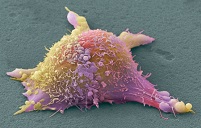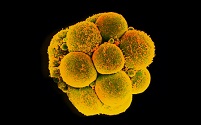РНК-интерференция в терапии рака. Часть 5.
 2423
2423 0
0
Хотя миРНК и микроРНК были открыты независимо друг от друга, оба этих типа малых РНК схожи по биогенезу, сборке в комплексы с белками и способности ингибировать экспрессию генов у различных эукариот (Bartel, 2004; Meister and Tuschl, 2004; Baulcombe, 2004; Mello and Conte, 2004). Dicer, фермент семейства РНКаз III, участвует в генерации обеих этих молекул, разрезая длинную дцРНК, формируя миРНК и разрезая молекулу-предшественницу микроРНК со структурой в виде шпильки, формируя микроРНК. На стадии формирования миРНК и микроРНК имеют вид двуцепочечных дуплексов, которые должны быть расщеплены перед связыванием с комплексом белков RISC.
Оценивая термодинамическую стабильность, миРНК можно разделить на 2 класса: симметричные миРНК и асимметричные миРНК. Концы симметричной миРНК одинаково стабильны, следовательно, обе цепи миРНК с одинаковой эффективностью связываются с комплексом белков RISC (Schwarz et al., 2003). У асимметричной миРНК один конец более стабилен, чем другой. Так как двуцепочечный предшественник миРНК проще расщепить с менее стабильного конца, одна из цепей получает преимущество при связывании с комплексом белков RISC (Schwarz et al., 2003; Khvorova et al., 2003). Интересен тот факт, что большинство миРНК являются высоко асимметричными, что повышает эффективность включения этих молекул в белковые комплексы RISC.
Биохимические исследования in vitro и in vivo показали, что RISC-комплекс с миРНК может функционировать так же, как RISC-комплекс с микроРНК, подавляя трансляцию мРНК-мишени. Аналогично, RISC-комплекс с микроРНК может функционировать так же, как RISC-комплекс с миРНК, расщепляя специфичную молекулу мРНК. Такая функциональная взаимозаменяемость между миРНК и микроРНК говорит о высокой схожести, если не о полной идентичности этих молекул (Hutvagner and Zamore, 2002; Tang.et al., 2003; Doench et al., 2003; Zeng et al., 2003). В то же время, существует множество доказательств, говорящих в пользу того, что миРНК-RISC и микроРНК-RISC представляют собой совершенно разные типы комплексов. Во-первых, биогенез, созревание и последующая сборка миРНК и микроРНК в комплексы проходит совершенно по-разному (Bartel, 2004).Во-вторых, белок Argonaute, неотъемлемый компонент белкового комплекса RISC, кодируется несколькими генами одного семейства и может экспрессироваться в виде различных белковых подгрупп (Carmell et al., 2002; Hammond et al., 2001; Liu et al., 2004; Song et al., 2004; Meister et al., 2004). Различные белки Ago могут придавать соответствующим RISC-комплексам разные свойства и функции. В-третьих, считается, что комплементарность между малыми РНК и их мРНК-мишенями влияет на функциональность RISC-комплекса с точки зрения регуляции стабильности мРНК и трансляции. Тем не менее, RISC-комплексы, содержащие малые РНК, высоко комплементарные к специфичной мРНК-мишени, не всегда осуществляют эффективное разрушение своей молекулярной мишени (Meister et al., 2004). В четвертых, миРНК-RISC-комплексы и микроРНК-RISC-комплексы направлены на разные по функциям мишени клетки. Большинство микроРНК и их RISC-комплексов регулируют экспрессию генов, связанных с ростом и развитием организма (Rhoades et al., 2002). А миРНК получают из дцРНК, синтезируемых in vitro или in vivo из вирусов или генетических последовательностей, получаемых методами генной инженерии. Двуцепочечные РНК также можно получать из эндогенных активированных транспозонов. Таким образом, к биологическим функциям миРНК можно отнести: (1) антивирусную защиту (Pfeffer et al., 2004; Ding et al., 2004), (2) расщепление избыточного количества мРНК в клетке, (3) защиту генома от транспозонов (Mello and Conte, 2004; Hannon, 2002; Tabara et al., 1999).
Заключение
Методы молекулярной биологии, позволяющие искусственно изменять функции генов, дают нам надежду на осознание и понимание регуляторных механизмов, контролирующих функционирование клеток.РНК-интерференция позволяет анализировать функции генов на клеточном уровне и представляет собой эффективную систему.
Источник:
Shafi G., Jamil K., Kapley A.et al.RNAi as a novel therapeutic platform technology for oncological solutions.Biotechnology and Molecular Biology Review 2008; 4(4): 55-70, с дополнениями и изменениями.
перевод: Мария Зайцева, Анаит Григорян
Литература:
Abbas-Terki T. et al.(2002).Lentiviral-mediated RNA interference. Hum.Gene Ther.2002; 13: 197-2201.
Ambros V.(2001). MicroRNAs: tiny regulators with great potential. Cell 2001;107: 23–826.
Ambros V (2004).The functions of animal microRNAs.Nature.431: 350–355.
Ancellin N.et al.(2001). Extracellular export of sphingosine kinase-1 enzyme: Sphingosine 1-phosphate generation and the induction of angiogenic vascular maturation. J.Biol.Chem.227: 6667–6675.
Aza-Blanc P.et al.(2003). Identification of Modulators of TRAIL-Induced Apoptosis via RNAi-Based Phenotypic Screening. Mol.Cell 12: 627–637.
Bakker J.et al.(2002). Methyl-CpG binding domain protein 2 represses transcription from hypermethylated p-class glutathione S-transferase gene promoters in hepatocellular carcinoma cells. J.Biol.Chem.17: 17.
Bartel D.P.(2004). MicroRNAs: genomics, biogenesis, mechanism, and function. Cell; 116: 281–297.
Baulcombe D.(2004). RNA silencing in plants. Nature 431: 356–363 4
Berezikov E.et al.(2005). Phylogenetic shadowing and computational identification of human microRNA genes. Cell 120: 21–24.
Berns K.et al.(2004). A large-scale RNAi screen in human cells identifies new
components of the pathway. Nature 428: 1-437.
Bitko V., Barik S.(2001). Phenotypic silencing of cytoplasmic genes using sequence-specific double- stranded short interfering RNA and its application in the reverse genetics of wild type negative- strand RNA viruses. BMC Microbiol.1: 34.
Braasch D.A.et al.(2004). Biodistribution of phosphodiester and phosphor-othioate siRNA. Bioorg Med.Chem.Lett.14: 1139-1143.
Brown J.R., Sanseau P.(2005). A computational view of microRNAs and their targets. Drug Discovery Today.10: 595–601.
Brummelkamp T.R.et al.(2002a). A system for stable expression of short interfering RNAs in mammalian cells. Sci.296: 550-553.
Brummelkamp T.R. et al.(2002b). Stable suppression of tumorigenicity by virus-mediated RNA interference. Cancer Cell 2: 243-247.
Calin G.A.et al.(2002). Frequent deletions and down-regulation of micro-RNA genes miR15 and miR16 at 13q14 in chronic lymphocytic leukemia. Proc.Natl.Acad.Sci.U.S.A.99: 15524–15529.
Calin G.A.et al.(2004b). Human microRNA genes are frequently located at fragile sites and genomic regions involved in cancers. Proc.Natl.Acad.Sci.U.S.A 101: 2999–3004.
Caplen N.J.et al.(2001). Specific inhibition of gene expression by small double stranded RNAs in invertebrate and vertebrate systems. Proc.Natl.Acad.Sci.USA 98: 9742-9747.
Carmell M.A.et al.(2003). Germline transmission of RNAi in mice. Nature Struct.Biol.10: 91–
92.
Carmell M.A. et al.(2002) The Argonaute family: tentacles that reach into RNAi, developmental control, stem cell maintenance, and tumorigenesis. Genes Dev.16: 2733–2742.
Carrington J.C., Ambros V.(2003). Role of microRNAs in plant and animal development. Sci.30: 336–338.
Ch.Kalyana K., Sudha M., Kaiser J.(2007). Possible Associations of Splice Site Mutation of Dihydropyrimidine Dehydrogenase (IVS14+1G>A) in Adverse Drug Reactions in Some Invasive Ductal Carcinoma Patients. Int.J.Pharmacol.3: 130-136.
Cheng A.M.et al.(2005a). Antisense inhibition of human miRNAs and indications for an involvement of miRNA in cell growth and apoptosis. Nucleic Acids Res.33: 1290–1297.
Chiu Y.L., Rana T.M.(2002). RNAi in human cells: basic structural and functional features of small interfering RNA. Mol.Cell 10: 549–561.
Choudhury A. et al.(2004). Small interfering RNA (siRNA) inhibits the expression of the Her2/neu gene, upregulates HLA class I and induces apoptosis of Her2/neu positive tumor cell lines. Int J Cancer; 108: 71–77.
Cimmino A.et al.(2005). miR-15 and miR-16 induce apoptosis by targeting BCL2. Proc.Natl.Acad.Sci.U.S.A.102: 13944–13949.
Ding S-W.et al.(2004). RNA silencing: a conserved antiviral immunity of plants and animals. Virus Res.102: 109–115.
Doench J.G. et al.(2003). siRNAs can function as miRNAs. Genes Dev.17: 438–442.
Dohner H.et al.(2000). Genomic aberrations and survival in chronic lymphocytic leukemia. N.Engl.J.Med.343: 1910–1916.
Dykxhoorn D.M., Novina C.D., Sharp P.A.(2003). Killing the messenger: short RNAs that silence gene expression. Nat.Rev.Mol.Cell Biol.4: 457-467.
Dykxhoorn D.M., Novina C.D., Sharp P.A.(2003). Killing the messenger: short RNAs that silence gene expression. Nature Rev.Mol.Cell Biol.4: 457–467.
Eis P.S. et al.(2005). Accumulation of miR-155 and BIC RNA in human B cell lymphomas. Proc.Natl.Acad.Sci.USA, 102: 3627-3632.
Elbashir S.M.et al.(2001c). Duplexes of 21- nucleotide RNAs mediate RNA interference in mammalian cell culture. Nature 411: 494–498.
Elbashir S.M. et al.(2001) Duplexes of 21-nucleotide RNAs mediate RNA interference in cultured mammalian cells. Nature; 411: 494–498.
Elbashir S.M. et al.(2001b). Analysis of gene function in somatic mammalian cells using small interfering RNAs. Methods 26: 199-213.
Elbashir S.M. et al.(2002). Analysis of gene function in somatic mammalian cells using small interfering RNAs. Methods 26: 199–213.
Elbashir S.M. et al.(2001a). RNA interference is mediated by 21 and 22 nt RNAs. Genes Dev.15: 188–200.
Elbashir S.M. et al.(2001b). Functional anatomy of siRNAs for mediating efficient RNAi in Drosophila melanogaster embryo lysate. EMBO J.20: 6877–6888.
Ewing B., Green P.(2000). Analysis of expressed sequence tags indicates 35,000 human genes. Nat.Genet.25: 232–234.
Filleur S.et al.(2003). SiRNA-mediated inhibition of vascular endothelial growth factor severely limits tumor resistance to antiangiogenic thrombospondin-1 and slows tumor vascularization and growth. Cancer Res.63: 3919–3922.
Fire S.et al. (1998). Potent and specific genetic interference by double-stranded RNA in Caenorhabditis elegans. Nature 391: 806-811.
Floyd S.et al.(2004). Gene regulation: ancient microRNA target sequences in plants. Nature 428: 485–486.
Griffiths-Jones S.et al.(2006). miRBase: microRNA sequences, targets and gene nomenclature. Nucleic Acids Res.34: 140–144.
Guo S.et al.(2006). Construction of a folate-conjugated pRNA of bacteriaphage phi29 DNA packaging motor for delivery of chimeric siRNA to nasopharyngeal carcinoma cells. Gene Therapy 13: 814-820.
Hall A.H.et al.(2004). RNA interference using boranophosphate siRNAs: structure-activity relationships. Nucleic Acids Res.32: 5991-6000.
Hammond S.M. et al.(2001). Argonaute2, a link between genetic and biochemical analyses of RNAi. Science 293, 1146–1150
Hannon G.J. (2002). RNA interference. Nature 418: 244–251.
Hao Y. et al. (1993). Tumour-suppressor activity of H19 RNA. Nature, 365: 764-767.
Haranatha R., Kaiser J. (2006). Polymorphism in the MTHFR gene and their possible association with susceptibility to childhood acute Lymphocyte Leukemia in an Indian population. Leukemia &Lumphoma.47:1333-1339.
Haranatha R., Kaiser J. (2006). Polymorphisms in the GST (M1 andT1) gene and their possible association with susceptibility to childhood acute lymphocytic leukemia in Indian population. Afr.J.Biotechnol.5: 1454-1456, 1417.
Hasuwa H. et al. (2002). Small interfering RNA and gene silencing in transgenic mice and rats. FEBS Lett.532: 227–230.
Hirai I., Wang H.G. (2002). A role of the C-terminal region of hRad9 in nuclear transport of the hRad9-hRad1-hHus1 checkpoint complex. J.Biol.Chem.277: 25722–25727.
Holen T. et al. (2002). Positional effects of short interfering RNAs targeting the human coagulation trigger Tissue Factor. Nucleic Acids Res.30: 1757–1766.
Hommel J.D. et al. (2003). Local gene knockdown in the brain using viral-mediated RNA interference. Nature Med.9: 1539–1544.
Howard K. (2003). Unlocking the money-making potential of RNAi. Nature Biotechnol.21: 1441–1446.
Hutvagner G., Zamore P.D. (2002). A microRNA in a multipleturnover RNAi enzyme complex. Sci.297: 2056–2060.
Iorio M.V. et al. (2005). MicroRNA gene expression deregulation in human breast cancer. Cancer Res.65: 7065–7070.
Jiang M. et al. (2004). Gel-based application of siRNA to human epithelial cancer cells induces RNA-independent apoptosis. Oligonucleotides, 14: 239-248.
Jocelyn H. et al. (2002). VEGF-Trap: A VEGF blocker with potent antitumor effects. PNAS, 99: 11393-11398.
Kaiser J. (2007). MiRNAs Rewrite the Rules of Molecular Biology, Res. J.Biotechnol.2: 3-5.
Kawasaki H., Taira K. (2003). Short hairpin type of dsRNAs that are controlled by tRNA(Val) promoter significantly induce RNAi-mediated gene silencing in the cytoplasm of human cells. Nucleic Acids Res. 31: 700–707.
Khaled A. et al. (2005). Controllable self-assembly of nanoparticles for specific delivery of multiple therapeutic molecules to cancer cells using RNA nanotechnology. Nano Letters.5: 1797-1808.
Khvorova A. et al. (2003). Functional siRNAs and miRNAs exhibit strand bias. Cell 115: 209–216.
Kim V.N. (2003). RNA interference in functional genomics and medicine. J.Korean Med.Sci.18: 309-318.
Kunath T. et al. (2003). Transgenic RNA interference in ES cell derived embryos recapitulates a genetic null phenotype. Nature Biotechnol.21: 559–561.
Lai EC. et al. (2003). Computational identification of Drosophila microRNA genes.Genome Biol.4, R42.
Landthaler M. et al. (2004). The human DiGeorge syndrome critical region gene 8 and its D.melanogaster homolog are required for miRNA biogenesis.Curr.Biol.14: 2162–2167.
Lee R.C., Ambros V. (2001). An extensive class of small RNAs in Caenorhabditis elegans. Science, 294: 862-864.
Lewis D.L. et al. (2002). Efficient delivery of siRNA for inhibition of gene expression in
postnatal mice. Nature Genet.32: 107–108
Lewis D.L. et al. ( 2002) Efficient delivery of siRNA for inhibition of gene expression in
postnatal mice.Nat Genet.32: 107–108.
Li K. et al. (2003). Use of RNA interference to target cyclin E-overexpressing hepatocellular carcinoma. Cancer Res.63: 3593–3597.
Lim L.P. et al. (2003a). Vertebrate microRNA genes. Sci.299: 1540.
Lim L.P. et al. (2003b). The microRNAs of Caenorhabditis elegans. Genes Dev.17: 991–1008.
Lin S.L. et al. (2001). A Novel mRNA-cDNA interference phenomenon for silencing bcl-2 expression in human LNCaP cells. Biochem.Biophys.Res.Commun.281:639-644.
Lisa N.P. et al. (2005). RNA Interference against Human papillomavirus oncogenes in Cervical Cancer Cells Results in Increased Sensitivity to Cisplatin. Mol.Pharmacol.68:1311–1319.
Liu J. et al. (2004). Argonaute2 is the catalytic engine of mammalian RNAi.Sci.305: 1437–1441.
Llave C. et al. (2002). Cleavage of Scarecrow-like mRNA targets directed by a class of Arabidopsis miRNA. Sci.297: 2053–2056.
Lois C. et al. (2002). Germline transmission and tissue-specific expression of transgenes delivered by lentiviral vectors. Science (Wash DC).295: 868–872.
Malhotra P. et al. (2002). Double-stranded RNA-mediated gene silencing of cysteine proteases (falcipain -1 and -2) of plasmodium falciparum. Mol.Microbiol.45: 1245-1254.
Mallory A.C. et al. (2004). MicroRNA control of PHABULOSA in leaf development: importance of pairing to the microRNA 50 region. EMBO J.23: 3356–3364
Martines L.M. et al. (2002). The serine protease Omi/HtrA2 regulates apoptosis by binding XIAP through a reaper-like motif. J.Biol.Chem.277: 439–444.
Martinez J. et al. (2002). Single-stranded antisense siRNAs guide target RNA cleavage in RNAi. Cell 110: 563–574.
Martinez J., Tuschl T. (2004). RISC is a 50 phosphomonoester-producing RNA endonuclease. Genes Dev.18: 975–980.
Martinez L.A. et al. (2002). Synthetic small inhibiting RNAs: efficient tools to inactivate oncogenic mutations and restore p53 pathways. Proc Natl Acad Sci USA; 99: 849–854.
McCaffrey A.P. et al. (2002). RNA interference in adult mice. Nature.418: 38–39
McCaffrey A.P. et al. (2003). Inhibition of hepatitis B virus in mice by RNA interference. Nature Biotechnol.21: 639–644.
McManus M.T. et al. (2002). Gene silencing using micro-RNA designed hairpins. RNA 8: 842–850.
McRobert L., McConkey G.A. (2002). RNA interference (RNAi) inhibits growth of Plasmodium falciparum. Mol.Biochem.Parasitol.199: 273-278.
Meister G. et al. (2004). Human Argonaute2 mediates RNA cleavage targeted by miRNAs and siRNAs. Mol.Cell 15: 185–197.
Meister G., Tuschl T. (2004). Mechanisms of gene silencing by double-stranded RNA. Nature 43: 343–349
Mello C.C., Conte D.Jr.(2004). Revealing the world of RNA interference.Nature 43: 338–342.
Metzler M. et al. (2004). High expression of precursor microRNA-155/BIC RNA in children with Burkitt lymphoma. Genes Chromosomes Cancer, 39: 167-169.
Michael M.Z. et al. (2003). Reduced accumulation of specific microRNAs in colorectal neoplasia. Mol.Cancer Res.1:882–891.
Miyagishi M. , Taira K. (2002). U6 promoter-driven siRNAs with four uridine 3’ overhangs efficiently suppress targeted gene expression in mammalian cells. Nature Biotechnol.20: 497–500.
Moskalenko S. et al. (2002). The exocyst is a Ral effector complex.Nat.Cell Biol.4: 66–72.
Muneesh T., Marc V. (2003). RNAi on the Apoptosis TRAIL The Mammalian Cell Genetic Screen Comes of Age.5: 534-535.
Nairz K. et al. (2006). Overgrowth caused by misexpression of a microRNAwith dispensable wildtype function. Dev.Biol.291: 314–324.
Napoli C. et al. (1990). Introduction of a chimeric chalcone synthase gene into petunia results in reversible cosuppression of homologous genes in trans. Plant Cell.2: 279–89.
Nieth C. et al. (2003). Modulation of the classical multidrug resistance (MDR) phenotype by RNA interference. FEBS Lett.545: 144–150.
Nykanen A. et al. (2001). ATP requirements and small interfering RNA structure in the RNA interference pathway. Cell 107: 309–321.
Paddison P.J. et al. (2002). Short hairpin RNAs (shRNAs) induce sequence-specific silencing in mammalian cells. Genes Dev.16: 948-958.
Pasquinelli A.E. et al. (2000). Conservation of the sequence and temporal expression of let-7 heterochronic regulatory RNA. Nature 408: 86–89.
Paul C.P. et al. (2002). Effective expression of small interfering RNA in human cells. Nature Biotechnol.20: 505–508.
Petrovics G. et al. (2004). Elevated expression of PCGEM1, a prostate-specific gene with cell growth promoting function, is associated with high-risk prostate cancer patients. Oncogene, 23: 605-611.
Pfeffer S. et al. (2004). Identification of virus-encoded microRNAs. Science 304, 734–736.
Pham J.W. et al. (2004). A Dicer-2-dependent 80s complex cleaves targeted mRNAs during RNAi in Drosophila. Cell 117: 83–94
Raymond M.S. et al. (2004). Cancer siRNA therapy by tumor selective delivery with ligand-targeted sterically stabilized nanoparticle. Nucleic Acids Res.32: p.19.
Reich S.J. et al. (2003). Small interfering RNA (siRNA) targeting VEGF effectively inhibits ocular neovascularization in a mouse model. Mol.Vis.9: 210–216.
Reynolds A. et al. (2004). Rational siRNA design for RNA interference. Nature Biotechnol.22: 326–330.
Rhoades M.W. et al. (2002). Prediction of plant microRNA targets. Cell 110: 513–520.
Rubinson D.A. et al. (2003). A lentivirus-based system to functionally silence genes in primary mammalian cells, stem cells and transgenic mice by RNA interference.Nat.Genet.33: 401-6.
Ruvkun G. et al. (2004). The 20 years it took to recognize the importance of tiny RNAs. Cell.116:S93-96.
Sanchez-Beato M. et al. (2003). Cell cycle deregulation in B-cell lymphomas. Blood 101: 1220–1235.
Scherr M. et al. (2003). Specific inhibition of bcr-abl gene expression by small interfering RNA. Blood, 101: 1566–1569.
Schwarz D.S. et al. (2003). Asymmetry in the assembly of the RNAi enzyme complex. Cell 115: 199–208.
Sham S.K., Mohammad T.M. (2006). Suppression of lung cancer with siRNA targeting PTTG: Int.j.oncol.29: 387-395.
Shen C. et al. (2003). Gene silencing by adenovirus-delivered siRNA. FEBS Lett.539: 111-114.
Shinagawa T., Ishii S. (2003). Generation of Ski-knockdown mice by expressing a long double-strand RNA from an RNA polymerase II promoter. Genes Dev.17: 1340–1345.
Song E. et al. (2003a). RNA interference targeting Fas protects mice from fulminant hepatitis. Nature Med.9: 347–351.
Song E. et al. (2003b). Sustained small interfering RNA-mediated human immunodeficiency virus type 1 inhibition in primary macrophages. J.Virol.77: 7174–7181.
Song J.J. et al. (2004). Crystal structure of Argonaute and its implications for RISC slicer activity. Sci.305: 1434 –1437.
Sorensen D.R. et al. (2003). Gene silencing by systemic delivery of synthetic siRNAs in adult mice. J.Mol.Biol.327: 761–766.
Soutschek J. et al. (2004). Therapeutic silencing of an endogenous gene by systemic administration of modified siRNAs. Nature, 432: 173-178.
Srikantan V. et al. (2000). PCGEM1, a prostate-specific gene, is overexpressed in prostate cancer.Proc. Natl.Acad.Sci.U.S.A, 97: 12216-12221.
Sui G. et al. (2002). A DNA vector-based RNAi technology to suppress gene expression in mammalian cells. Proc.Natl.Acad.Sci.USA.99: 5515-5520.
Sui G. et al. (2002). A DNA vector-based RNAi technology to suppress gene expression in mammalian cells. Proc.Natl.Acad.Sci.99:5515–5520.
Sui G.et al.(2002). A DNA vector-based RNAi technology to suppress gene expression in mammalian cells. Proc.Natl Acad.Sci.U.S.A.99, 5515–5520.
Suman G., Kaiser J. (2006). Novel CYP3A4 Gene Polymorphisms in Post Chemo Breast Cancer Patients: International J. Cancer Res.2: 358-366.
Tabara H. et al. (1999). The rde-1 gene, RNA interference, and transposons silencing in C. elegans. Cell 99: 123–132.
Tang G. et al. (2003). A biochemical framework for RNA silencing in plants. Genes Dev.17: 49–63
Tanno B. et al. (2005) Silencing of endogenous IGFBP-5 by micro RNA interference affects proliferation, apoptosis and differentiation of neuroblastoma cells. Cell Death Differ.12: 213–223.
Tuschl T., Borkhardt A. (2002). Small interfering RNAs - A revolutionary tool for analysis of gene function and gene therapy. Mol.Intervent.2: 42–51.
Tuschl T. et al. (1999). Targeted mRNA degradation by double-stranded RNA in vitro. Genes
& Dev.13: 3191–3197.
Ui-Tei K. et al. (2004). Guidelines for the selection of highly effective siRNA sequences for mammalian and chick RNA interference. Nucleic Acids Res.32: 936–948.
Uwe S. et al. (2000). A gene expression database for the molecular pharmacology of cancer,
nature genetics, 24: 236-244.
Venter J.C. et al. (2001). The sequence of the human genome. Sci.291(5507):1304–1351.
Verma U.N. et al. (2003). Small interfering RNAs directed against beta-catenin inhibit the in vitro and in vivo growth of colon cancer cells. Clin.Cancer.Res.9: 1291–1300.
Wall N.R., Shi Y. (2003). Small RNA: can RNA interference be exploited for therapy? Lancet 362: 1401-1403.
Wei W. et al. (2005). Identification of effective siRNA against K-ras in human pancreatic cancer cell line MiaPaCa-2 by siRNA expression cassette: World J Gastroenterol.11:2026-2031.
Wen-Hua Xu. et al. (2007). Inhibitory effect of vascular endothelial growth factors-targeted small interfering RNA on proliferation of gastric cancer cells: World J. Gastroenterol. 13: 2044-2047.
Wilda M. et al. (2002). Killing of leukemic cells with a BCR/ABL fusion gene by RNA interference (RNAi). Oncogene 21: 5716–5724.
Xia H. et al. (2002). siRNA-mediated gene silencing in vitro and in vivo. Nature Biotechnol.20: 1006–1010.
Yang G. et al. (2003). Silencing of H-ras gene expression by retrovirus-mediated siRNA decreases transformation efficiency and tumor growth in a model of human ovarian cancer. Oncogene.22: 5694–5701.
Yangchao C. et al. (2003). Down regulation of CXCR4by inducible small interfering RNA breast cancer cell invasion in vitro. Cancer Res.63: 4801 – 4804.
Yi-hua W. et al. (2005). Knockdown of c-Myc expression by RNAi inhibits MCF-7 breast tumor cells growth in vitro and in vivo. Breast Cancer Res.7: R220-R228.
Yoshinouchi M. et al. (2003). In vitro and in vivo growth suppression of human papillomavirus 16-positive cervical cancer cells by E6 siRNA. Mol.Ther.8: 762–768.
Yu J.Y. et al. (2003). Simultaneous inhibition of GSK3 using hairpin siRNA expression vectors. Mol.Ther.7: 228–236.
Zender L. et al. (2003). Caspase 8 small interfering RNA prevents acute liver failure in mice. Proc.Natl Acad.Sci.U.S.A. 100: 7797–7802.
Zeng Y. et al. (2003). MicroRNAs and small interfering RNAs can inhibit mRNA expression by similar mechanisms. Proc.Natl.Acad.Sci.U.S.A.100: 9779–9784.
Zhang B.H. et al. (2006a). Conservation and divergence of plant microRNA genes. Plant J.46: 243–259.
Zhang B.H. et al. (2006b). Plant microRNA: a small regulatory molecule with big impact. Dev.Biol.289: 3–16.
Zhang B.H. et al. (2005). Identification and characterization of new plant microRNAs using EST analysis. Cell Res.15: 336–360.





